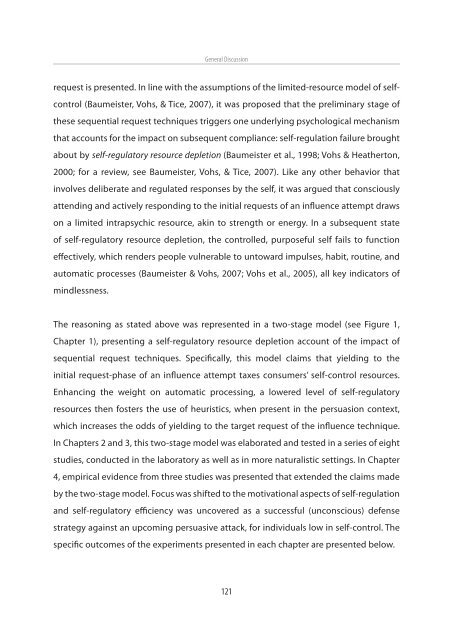Chapter 1 - Universiteit Twente
Chapter 1 - Universiteit Twente
Chapter 1 - Universiteit Twente
You also want an ePaper? Increase the reach of your titles
YUMPU automatically turns print PDFs into web optimized ePapers that Google loves.
General Discussion<br />
request is presented. In line with the assumptions of the limited-resource model of selfcontrol<br />
(Baumeister, Vohs, & Tice, 2007), it was proposed that the preliminary stage of<br />
these sequential request techniques triggers one underlying psychological mechanism<br />
that accounts for the impact on subsequent compliance: self-regulation failure brought<br />
about by self-regulatory resource depletion (Baumeister et al., 1998; Vohs & Heatherton,<br />
2000; for a review, see Baumeister, Vohs, & Tice, 2007). Like any other behavior that<br />
involves deliberate and regulated responses by the self, it was argued that consciously<br />
attending and actively responding to the initial requests of an influence attempt draws<br />
on a limited intrapsychic resource, akin to strength or energy. In a subsequent state<br />
of self-regulatory resource depletion, the controlled, purposeful self fails to function<br />
effectively, which renders people vulnerable to untoward impulses, habit, routine, and<br />
automatic processes (Baumeister & Vohs, 2007; Vohs et al., 2005), all key indicators of<br />
mindlessness.<br />
The reasoning as stated above was represented in a two-stage model (see Figure 1,<br />
<strong>Chapter</strong> 1), presenting a self-regulatory resource depletion account of the impact of<br />
sequential request techniques. Specifically, this model claims that yielding to the<br />
initial request-phase of an influence attempt taxes consumers’ self-control resources.<br />
Enhancing the weight on automatic processing, a lowered level of self-regulatory<br />
resources then fosters the use of heuristics, when present in the persuasion context,<br />
which increases the odds of yielding to the target request of the influence technique.<br />
In <strong>Chapter</strong>s 2 and 3, this two-stage model was elaborated and tested in a series of eight<br />
studies, conducted in the laboratory as well as in more naturalistic settings. In <strong>Chapter</strong><br />
4, empirical evidence from three studies was presented that extended the claims made<br />
by the two-stage model. Focus was shifted to the motivational aspects of self-regulation<br />
and self-regulatory efficiency was uncovered as a successful (unconscious) defense<br />
strategy against an upcoming persuasive attack, for individuals low in self-control. The<br />
specific outcomes of the experiments presented in each chapter are presented below.<br />
121
















